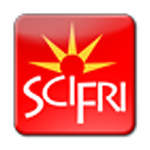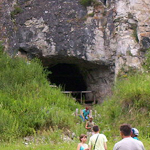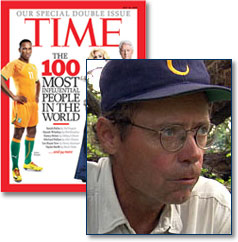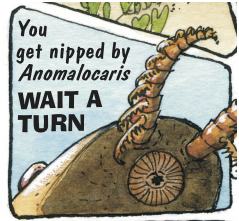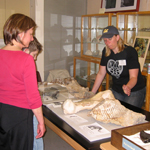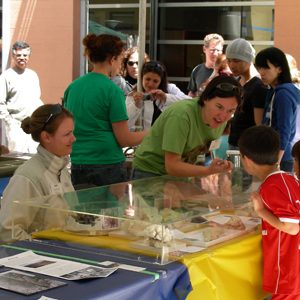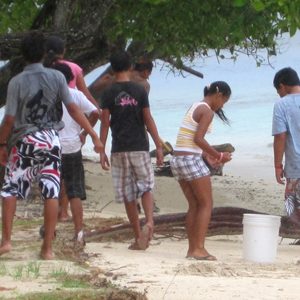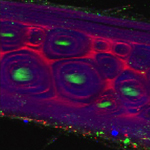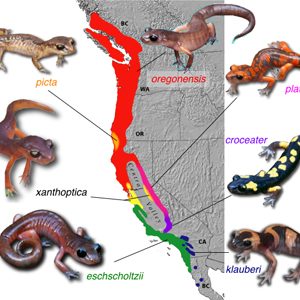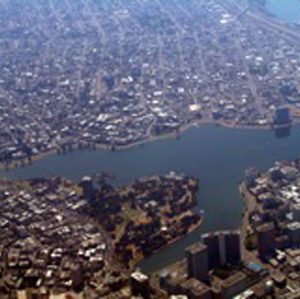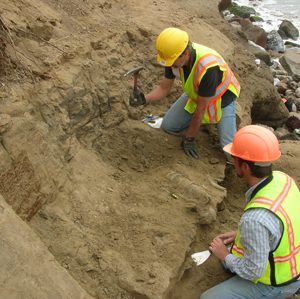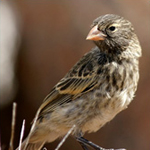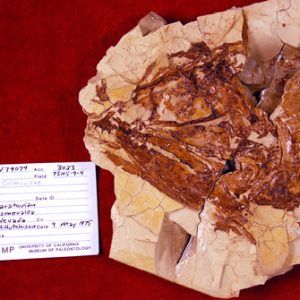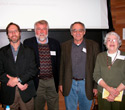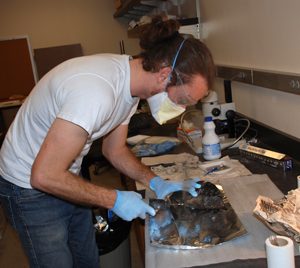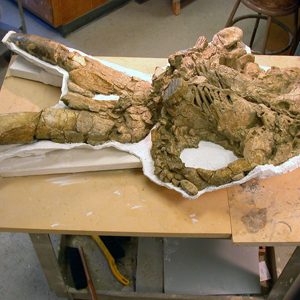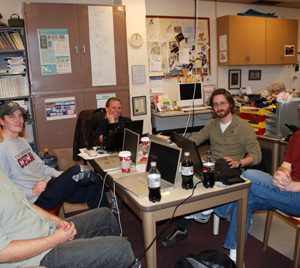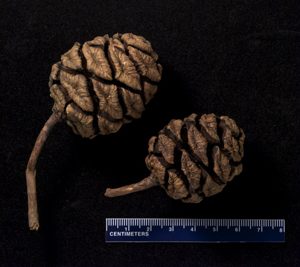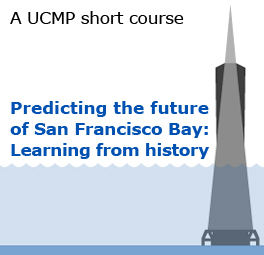This week, we've launched a new online special exhibit — Fossil eggshell: Fragments from the past. This is the best online source of information about fossil eggshell — you can't find this info anywhere else! This special exhibit was created in collaboration with Laura E. Wilson, Karen Chin and Emily S. Bray, from the University of Colorado, Boulder, and Frankie D. Jackson from Montana State University. We can learn a lot from fossil eggshell. Using scanning electron microscopy, we can examine … [Read more...] about Special exhibit: Fossil eggshell
Latest News
UCMP’s Tony Barnosky on Science Friday
Mounting evidence suggests we may be on the cusp of a major extinction event. Last week, UCMP Faculty Curator Tony Barnosky talked about modern extinctions on Science Friday, a weekly science talk show on NPR. Tony was joined by Barry Sinervo, Professor at UC Santa Cruz, George Amato, of the Sackler Institute and the American Museum of Natural History, and Vance Vredenburg, Assistant Professor at San Francisco State University. In a lively conversation, Tony and the guests discussed many … [Read more...] about UCMP’s Tony Barnosky on Science Friday
Evo in the news: Making sense of ancient homonin DNA
When archaeologists discovered a 40,000 year old pinky bone in a Siberian cave, everyone wondered who the bone belonged to. Researchers extracted DNA from the fossil and used it to construct an evolutionary tree to see how the pinky bone's owner was related to modern day humans and Neanderthals. Scientists were surprised by what they found — read more about it in this month's Evo in the news: Making sense of ancient homonin DNA. Each month, the UCMP's Understanding Evolution website features an … [Read more...] about Evo in the news: Making sense of ancient homonin DNA
Congratulations Tim White!
Congratulations are due to Tim White, Director of the Human Evolution Research Center and Faculty Curator at the UCMP! Tim was selected by Time Magazine as one of The 100 Most Influential People in the World. Tim receives this recognition for his work on human evolution. This past fall, Tim and his colleagues published numerous papers on Ardipithecus ramidus, the oldest and most complete skeleton of a human ancestor. Congratulations, Tim! … [Read more...] about Congratulations Tim White!
The game of prehistoric life
Evolve or Perish is a new board game – not from the makers of Monopoly, but from ETE, the Evolution of the Terrestrial Ecosystems Program, at the Smithsonian National Museum of Natural History. UCMP Faculty Curators Cindy Looy and Ivo Duijnstee designed the game in collaboration with illustrator Hannah Bonner. Hannah is well-known for her cartoon paleobooks When Bugs Were Big and When Fish Got Feet. The three enjoy collaborating -- Hannah created the logo for Cindy's lab's web site, and she is … [Read more...] about The game of prehistoric life
Cal Day at the UCMP
Thanks for joining us on Cal Day! Here are some photos from a few of the UCMP's Cal Day events. At Fun with Fossils, visitors used microscopes to look for fossils. They picked through matrix collected at the Bug Creek Anthills in Montana. People found reptile vertebrae, fish scales… and one little girl found a dinosaur tooth! The courtyard of VLSB was buzzing as hundreds of visitors perused the Biodiversity Roadshow. This exhibit included specimens from many of the Berkeley Natural History … [Read more...] about Cal Day at the UCMP
Visit the UCMP on Cal Day!
Join us at the UCMP on Cal Day, Saturday April 17! Events run from 9am to 4pm; check the schedule for a full listing of activities. Here are just a few of the Cal Day events at the UCMP: ~ Take a tour of the collections with a museum scientist. The collections are open to the public just one day a year, so this is your chance! Tours are held throughout the day, but tickets are first-come, first- served, and they go fast — come early to pick up your free tickets in advance. ~ Visit the special … [Read more...] about Visit the UCMP on Cal Day!
Middle schoolers and marine biodiversity in Moorea
Scientists from institutions like the UCMP travel all around the world and interact with many local communities. Last year the Berkeley Natural History Museums launched a project called the GK-12 Moorea fellowship to foster collaboration between graduate students and local communities in Moorea, French Polynesia. The program sends one graduate student to Moorea, a small island about 10km from Tahiti, to teach interactive science lessons in public schools and do ecological research. As the … [Read more...] about Middle schoolers and marine biodiversity in Moorea
X-ray analysis of fossil whale baleen
Two years ago I approached UCMP Assistant Director Mark Goodwin and asked if he had any room for some student help in his research. I had no previous experience in paleontology, just a passion for learning about dinosaurs and biology. Now, as a third-year graduate student in the Department of Materials Science and Engineering, I work on a variety of projects with Mark and the UCMP. For my own research, I study the micro- and nano-scale features in fossil bone with electron microscopy. I have … [Read more...] about X-ray analysis of fossil whale baleen
Highlights from Understanding Evolution
Ring species are often touted as examples of speciation in action — and the Ensatina salamander, which forms a ring around California's Central Valley, is a classic example. Biologists discovered this ring species back in the 1950s, and investigations of Ensatina continue today. Learn more about Ensatina in this research profile of biologist Tom Devitt, on the UCMP's Understanding Evolution website. Tom is a graduate student in Integrative Biology here at UC Berkeley. The profile follows him … [Read more...] about Highlights from Understanding Evolution
Creatures from the black lagoon
Very little was known about wetland ecology back in 1869, when Samuel Merritt dammed a former tidal slough and began developing its surrounding wetland as his "Jewel of Oakland." By restricting the flow of waters in and out of the newly created tidal lagoon, a.k.a. Lake Merritt, silt and algae were allowed to accumulate and within a few years the lake had become a bit of an environmental disaster. Nevertheless, part of it was designated by Teddy Roosevelt as our nation's first wildlife refuge, … [Read more...] about Creatures from the black lagoon
Fossils found fortuitously
Not all fossils are discovered by paleontologists combing the earth on special expeditions. Many fossils are found by accident — particularly during construction projects. Impressive fossils, like whales, mammoths, and sloths, have been found while digging foundations for buildings, leveling land for highways, and excavating subway tunnels. This spring, the UCMP blog will take you on a tour of Bay Area construction sites, past and present, to show you some of the fossils underfoot in the … [Read more...] about Fossils found fortuitously
Evo in the news: Speciation in real time
Speciation isn't always slow — sometimes, we can see evidence of evolution over a very short period of time. This month's Evo in the news: Speciation in real time looks at two examples of speedy speciation. The Central European blackcap, a bird, could be on the verge of a speciation event — over the past 30 years, researchers have seen a split in the behavior and morphology of two groups of blackcaps. Speciation has occurred in another bird species over a similar time period: the Galapagos … [Read more...] about Evo in the news: Speciation in real time
Fish in the UCMP
It is pretty unusual to see fish in the UCMP. It’s not that we don’t have any fish specimens — we have over a million fossilized fish fragments. It’s just that none of our museum scientists focus on fish, and so the museum’s fish parts tend to stay in the cabinets. But this past summer, Ralph Stearley of Calvin College visited the UCMP, and he did a little fishing. Ralph pulled some spectacular specimens from the murky depths of the cabinets. The two specimens shown here are exceptional — … [Read more...] about Fish in the UCMP
Predicting the future of San Francisco Bay: Learning from history
Hundreds of thousands of people cross San Francisco Bay each day. But as commuters zip through the BART tunnel or drive over the bridges, they probably don't think about what the Bay looked like in the past — or what it will look like in the future. On Saturday, February 6, over 150 people attended the UCMP's annual Short Course, Predicting the future of San Francisco Bay: Learning from history. Throughout the course's five talks, they saw a very different view of San Francisco Bay. A theme … [Read more...] about Predicting the future of San Francisco Bay: Learning from history
How many mammoths?
A few weeks ago, the UCMP welcomed visitor Jake Enk, a graduate student from McMaster University in Hamilton, Ontario. Jake visited the UCMP to saw off chunks of fossil mammoth teeth. Yes, you read that right. He took a small saw, sterilized the blade with bleach, and sliced off a small piece of tooth. Even after tens of thousands of years, mammoth teeth still contain DNA. Jake will put a little piece of the tooth in a test tube, and use a series of chemicals to purify the mammoth DNA. He does … [Read more...] about How many mammoths?
Lupé’s story, part 2: Prototyping the mammoth exhibit
UCMP graduate student Kaitlin Maguire is working with the Children’s Discovery Museum in San Jose to develop a new exhibit about the life of Lupé, a mammoth fossil that was found in the nearby Guadalupe River. This is the second in a series of blogs about Lupé and the new exhibit. Read Kaitlin’s first Lupé blog here. Development of the Lupé Story Exhibition is moving along quickly as exhibit ideas come to life in prototyping labs, in which the development team at the Children’s Discovery … [Read more...] about Lupé’s story, part 2: Prototyping the mammoth exhibit
Collaborating, with the help of the collections
A few weeks ago, we blogged about the discovery of a new species of dinosaur, Tawa hallae. Two UCMP alums, Sterling Nesbitt and Randy Irmis, described this new dino in the journal Science. A few weeks ago, Sterling, Randy, and two of their Tawa co-authors, Nate Smith and Alan Turner, visited the UCMP. They've come from Texas, Utah, Illinois, and New York, to work together and delve into the UCMP's collections. Along with UCMP Faculty Curator Kevin Padian and graduate student Sarah Werning, they … [Read more...] about Collaborating, with the help of the collections
Conifer evolution workshop
If there were a Guinness Book of World Records for conifers, California would be one of the top record holders: the Golden State has the tallest conifer, the most massive conifer, and the oldest conifer. Learn much more than just conifer trivia at an upcoming workshop, The Origin and Evolution of Conifers, co-hosted by the UCMP and The Jepson Herbarium. Through talks, discussions, and a hands-on lab, you'll learn all about the origin, evolution, and diversification of this unique plant group. … [Read more...] about Conifer evolution workshop
UCMP short course: Predicting the future of San Francisco Bay
How will sea level rise and climate change affect San Francisco Bay in the coming years? To predict the future, we need to look at the past — history shows us that San Francisco Bay has undergone some major changes throughout its history. Learn more about the Bay at this year's UCMP Short Course, Predicting the future of San Francisco Bay: Learning from history. This all-day course will be on Saturday, February 6, at UC Berkeley. It features talks by five renowned Bay Area scientists, as well as … [Read more...] about UCMP short course: Predicting the future of San Francisco Bay

